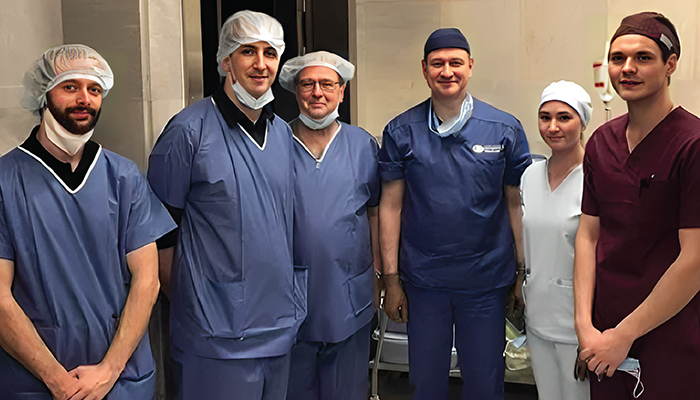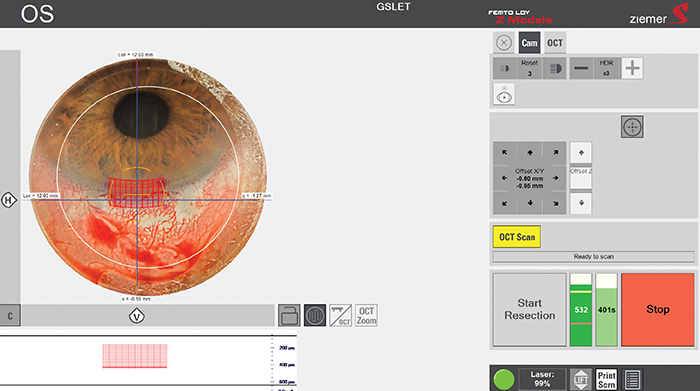
Boris Malyugin, Professor of Ophthalmology and Deputy Director General, S. Fyodorov Eye Microsurgery State Institution in Moscow, has been heavily involved in a project that seeks to enhance safety and reproducibility of limbal stem cell transplants through the application of a femtosecond laser more typically used for refractive, cataract and therapeutic surgery. Here, we dig into the condition and the collaboration to improve treatment.
What are the main challenges in addressing limbal stem cell deficiency?
When I started treating patients with limbal stem cell deficiency (LSCD), I realized how challenging it would be just to establish a correct diagnosis and distinguish it from many other ocular conditions involving corneal neovascularization. Clearly, you need the correct diagnosis to build the proper treatment strategy. Luckily, we now have several tools to help us – in addition to studies of the pattern of corneal staining with low molecular weight fluorescein. For example, sophisticated analysis of specific keratins expressed by corneal and conjunctival epithelium has been done with the help of immunohistochemistry. High resolution optical coherence tomography (OCT) with epithelial mapping and angiography, as well as corneal confocal microscopy, have also proved very helpful. Unfortunately, only big treatment centers can afford to invest into these expensive and time-consuming technologies and employ those people who are knowledgeable enough in ocular surface disorders.
Another challenge has been finding the best treatment strategy for each specific patient. In some cases, we need multi-stage treatment, especially with chemical burns and trauma, when collaborative work with an oculoplastic team might be necessary. And then there is the surgical procedure itself. And that’s where femtosecond lasers could play a more major role thanks to their intrinsic characteristic: high precision, minimal collateral damage, short learning curve, and the elimination of human errors. All of these factors yield better outcomes.
How exactly can femtosecond lasers help treat LSCD?
In 2018, we developed a procedure called glueless simple limbal epithelial transplantation (GSLET). In 2020, the technique was published in the journal Cornea, and four years later we presented the mid-term results (1,2). In GSLET, we create eight partial-thickness corneal tunnels located in the periphery of the affected cornea and put in limbal fragments harvested from the subject’s healthy, unaffected eye. In this way, we create specific limbal stem cell (LSC) reservoirs rather than place them on the surface of the cornea as happens with the other techniques. These LSC niches serve as bioreactors that generate new epithelial cells that repopulate the corneal surface and restore its normal anatomy.
For us, the next logical step was to use a femtosecond laser to create the corneal tunnels. These tunnels have a specific configuration to allow limbal fragments to be fixated inside them without use of additional sutures, thus decreasing the collateral damage. This technology is called femtosecond laser-assisted GSLET or FS-GSLET and it has proved very successful. Our study results are currently under review for publication by one of the major journals in the field.
The latest innovation is in using the same laser – namely, Ziemer’s FEMTO LDV Z8 – to harvest the LSCs. This process, when performed manually, requires advanced skills and is not very intuitive. Again, the laser helps us conduct this procedure in a more controlled and precise manner, which enhances the surgical outcome.
Personally, I believe that, with this laser, an average surgeon can become a very good one, and a very good surgeon can become perfect. And maybe the average one will also become perfect at some point!
Why the Ziemer Z8?
Well, I have partnered with various companies, big, small, and medium-sized. And I can say that, though the big players are very powerful and good at what they do, the internal decision-making process usually is slow and sometimes very complicated... My experience with Ziemer has been the opposite. The company does its best to stay close to the surgeon, lowering the barriers and listening carefully to the clinical needs. The feedback to requests is almost immediate, and that is a great driver for innovation!

Toward an “All-Laser” Approach
Fabian Müller, Director, Clinical Research & Application at Ziemer Ophthalmic Systems, gives his take on the Z8–limbal cell transplant project
“A few years ago, Professor Malyugin approached my colleague about using the laser to harvest limbal stem cells. We spent many long days with his team in the lab, followed by going to the eye bank to analyze the samples for survivability and growth rate. The glueless manual approach aims to replace the use of fibrin glue in simple limbal epithelial transplantation (SLET). We knew that the Z8 model with its built-in OCT system is great for avoiding perforations, thus providing an extra layer of safety. So we came up with the ‘all-laser’ approach, where the laser is used for both harvesting the transplants and fixing them on the diseased cornea.
“We really appreciate the learning opportunities brought about by collaborations with surgeons such as Professor Malyugin, drawing on their innovative thinking and understanding that the laser can be used for a lot more than LASIK or cataract surgery.
“Any new developments take time to get established, but our experience has been that good ideas propagate almost on their own. Migrating complex manual therapeutic treatments like SLET, CAIRS, or DALK to a laser-guided approach not only flattens the learning curve for new surgeons, but speeds up surgery time while boosting reproducibility, efficacy, and safety. That in turn improves cost for both surgeon and patient. Since many surgeons already use a FEMTO LDV Z8 for refractive or cataract procedures, it does not require getting used to a new, specialized device.”
References
- BE Malyugin et al., “Glueless simple limbal epithelial transplantation: Report of the first two cases,” Cornea, 39, 1588 (2020).
- BE Malyugin et al., “Midterm outcomes of autologous glueless simple limbal epithelial transplantation for unilateral limbal stem cell deficiency,” Cornea, 43, 45 (2024).
